Palo Alto College
San Antonio, Texas
SMALL TOWN HISTORY: HELOTES, TEXAS
| Michael R. Causey
| Fall 1998
|
| History 1301
| Hines |
Click on map to see larger view.
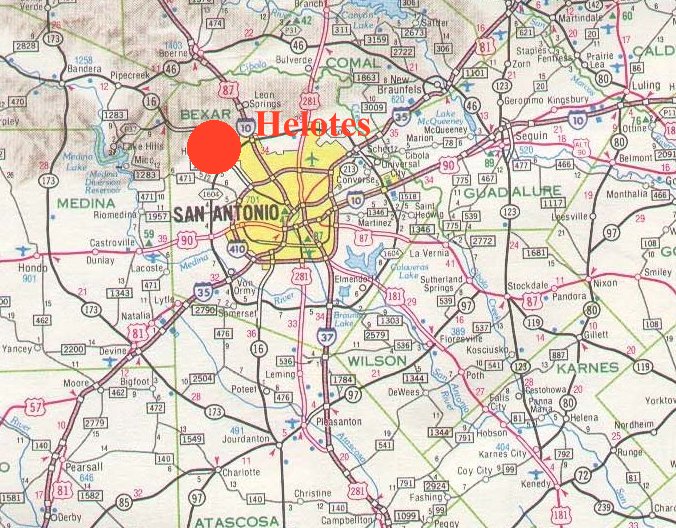 The present day city of Helotes lies approximately 12 miles (direct line) Northwest of downtown San Antonio. The South-East boundary of this small, irregularly shaped municipality is now one fourth of a mile from the North-West boundary of its large, aggressive neighbor. Helotes incorporated in 1981. A 1995 almanac survey based on estimates by local officials lists the population at 1,979, and the businesses at 205.
It is currently experiencing a growth spurt accompanied by pressure from large developers to downsize the size of lots required for new homes. City Council is evenly split regarding requests to downsize lot sizes. Sandra Day O'Connor High School has been built there by the North Side Independent School District, in spite of doubts about the need for that facility.
ORIGINS:
The present day city of Helotes lies approximately 12 miles (direct line) Northwest of downtown San Antonio. The South-East boundary of this small, irregularly shaped municipality is now one fourth of a mile from the North-West boundary of its large, aggressive neighbor. Helotes incorporated in 1981. A 1995 almanac survey based on estimates by local officials lists the population at 1,979, and the businesses at 205.
It is currently experiencing a growth spurt accompanied by pressure from large developers to downsize the size of lots required for new homes. City Council is evenly split regarding requests to downsize lot sizes. Sandra Day O'Connor High School has been built there by the North Side Independent School District, in spite of doubts about the need for that facility.
ORIGINS:
A brief geological history of Helotes includes time spent under ancient seas, and shifts in the earth's crust along the Balcones Fault about 50 million years ago which lifted parts of northern Helotes as high as 2,000 feet over the southern end. That geological event created aquifers and springs in an area rich in and wildlife. The area contains both sweeping hill country and flat, fertile land.
The choice land described above has shaped the history of Helotes. This prize has been seized by one group and then another and another until I am reminded of a day at the beach, watching seagulls snatching a morsel from each others' beaks.
Distant Helotes history is filled with voids, and uncertainty usually exists whenever anything is known. As events come closer to the present, the voids shrink to non-existence, and the hazy images of the past become clear, almost sharp. Looking through this haze by examining artifacts (on display at UTSA) anthropologists tell us that unidentified groups of Indians were using the Helotes area at least 7,000 years ago.
Moving from prehistoric times to recorded history, groups of Indians known to inhabit or pass through the area include Lipan Apache, and Comanche. The time of their arrival and the persistence of their presence is unclear, since these were Paleolithic groups, who sometimes migrated with game. The area game at some point included bear, and of greater interest to migrating Indians, buffalo.
"FOUNDING FATHERS":
According to The New Texas Handbook, 1996, Helotes was settled by Mexicans around 1856. These settlers intermarried with Apaches in the area, and included a man named Chaca, who is said to be the first to build a house, the first to cultivate corn there,
and the possible origin for the name Helotes, which translates to "green roasting ear of corn".
This source seems to be in disagreement with The Handbook Of Texas, 1952, which translates Helotes as "green maize", and with "an old cowboy", who saw the historical marker outside of the Gugger home (now Helotes Bicycle) and stopped in to say that the name Helotes had nothing to do with corn, because it came from an Indian word "wahelotes" (spelling uncertain ), which meant "wild turkey". He added that Government Canyon was previously known as Wahelotes Canyon. This explanation is given some plausibility beyond that normally granted to anonymous old cowboys by the fact that Government Canyon is even now widely known for its large wild turkey flocks.
The view that a man named Chaca is a figure in Helotes history, or that Mexicans had not settled the area before 1856 is regarded with amusement by local amateur historians, who are quick to explain that the Menchaca family lives off Scenic Loop Rd. in Grey Forest (once part of Helotes), that the family includes Apache Indians, and can easily trace its arrival in Helotes back to pre-date the first land sales.
Their ancestor, General Juan Menchaca was given a Spanish land grant that included a very large area reaching from Grey Forest to near Austin. When Mexico defeated Spain to gain her independence, General Menchaca was on the losing side, since he led royalist troops. After the war he did not want to return to Spain, so he and a number of his solders settled in the Grey Forest area. Although the Madlin ranch is owned by a Menchaca and remains in the family today, little is left of the Menchaca lands because of Juan Menchacas reluctance to "prove out" the land by fencing it.
HISTORICALLY SIGNIFICANT STORIES?:
After the Texas revolution, the Republic Of Texas was in desperate
need of funding. The young nation took its greatest wealth, land, and put it on the market in the form of scrip. Scrip were notes for a given number of acres of land in The Republic Of Texas. Using scrip, the owner could survey and claim any land in Texas not already "owned". Scrip was sold inside and outside of Texas, usually by a company dealing in real estate, such as the Toby Company.
The paper trail which eventually leads us to the center of "Old Helotes" begins with Toby Scrip Certificate #785, which was sold to Almazon Huston on 10 October, 1836. He was the Quartermaster General of the Army of Texas. The next clue is the sale of 10 certificates of scrip by Almazon Huston to John M. Ross. The sale took place in Natchez Missouri on 12 November, 1836. After Ross died in debt, Toby scrip #785 was sold to a well known local named Thomas Devine, on 2 January, 1852. Working with his eventual partner, Francis Giraud, Devine took the necessary steps to patent the land rights held in the certificates, then sold his interests to Giraud. On 5 October 1858, Giraud sold J.M. Ross survey #222 to a Dr. George Frederick Marnoch, a Scottish immigrant who had served the Royal Scottish Navy as a surgeon. The Marnoch home still stands. On 28 December 1880, Dr. Marnoch's heirs 'conveyed' 110 acres to an Arnold Gugger (a Swiss immigrant) who built his home next door to his mercantile store, thus establishing what is now known as 'Old Helotes'.
Life was not entirely peaceful while the Helotes farming and ranching community developed. Evidently the Lipan Apache and the Comanche fought each other. The Lipan Apache moved (were pushed?) toward Mexico. Indian relationships with Mexican and European immigrants were evidently ambivalent. Indians were known to marry into the immigrant groups. At the same time, violent attacks did occur. Kyle Cunningham mentions that in 1854 Frederick Olmsted reported traveling toward Helotes in the company of Indians. That night, the ranch in Helotes where Olmsted and a companion had considered staymg was attacked by Indians. Olmsted felt it was the same group. A settler, S.A. Lee, reports that he and his father were chased in 1871. "Father had a rifle and a six shooter, but there were eight Indians, with only two of us." Lee also mentions that Mrs. Martinez was killed (murdered) by Indians. In 1878, the postmaster, Carl Mueller, was killed by Indians. Although these dates and events are spread out considerably, I am by no means sure that they represent the entire picture of hostilities. Some of the settlers were known to keep homing pigeons for signaling attacks. It is said that when you approached a friendly residence. you did so while speaking very loudly. My interpretation is that this was a means of preventing "friendly fire".
A uniquely American resolution to the Indian problem commenced in 1870, when a group of Comanche raided Mr. Jacob Hoffmann and his neighbors. The Comanche wounded the neighbor's dog with an arrow, made whooping sounds, killed, skinned and ate part of a mare, stole 30 or 40 horses, wounded Hoffmann when he tried to trail them, fired the prairie grass to shake the U.S. Army, then killed an entire family in Helotes the next night. Evidently Hoffmann decided that a man's got to do what a man's got to do. He got a lawyer and sued the United States and Comanche Tribe for $1,420. Case #2891 raged on until 1917, by which time Jacob was deceased, and his son Charles Hoffmann was carrying on the battle. On 28 May 1917 the Hoffmann family finally won its case, and a judgment of $695 was awarded them. Thus was the wild West finally made safe for immigrants.
Of course there is more history in Helotes. The stage line came and went. The names of the drivers are even known. Dr. George Marnoch's medical skills were a blessing to the community. His son Dr. Gabriel Marnoch was a less talented physician, but became a respected naturalist. A dance hall and boarding house were built in Old Helotes, where cowboys would corral their stock next to Helotes Creek, and camp across the street. A fellow named Bert Hileman bought the Gugger place. Hileman was the key to getting the old Bandera Road paved, opened the first filling station, then sold downtown Helotes in 1919, when the area experienced a serious population decline. By then Lieutenant Dwight D. Eisenhower had visited Helotes a number of times, as had Lieutenant Robert E. Lee.
ECONOMY:
The future of Helotes is the future of any sparsely occupied, pristine land next to an expanding population center. People will come in ever-increasing numbers, just as they always have. Some of the present population will resist with will and skill, just like the Indians. Some will see advantages in new alliances and accept newcomers, just like the Indians.
The economic future of Helotes is bright, in a sense. It will no longer be a farming and ranching community, because the land will become too valuable to hold. It will be sold in ever smaller pieces as it becomes increasingly precious. Developers will put new homes on land that (unlike the present locations) is subject to flooding. Business of all kinds will spring up. I have already heard that the new single home sewage treatment units are maintenance intensive.
FUTURE PROSPECTS:
The ecology of Helotes does not have such a bright future. The Edwards and Glen Rose aquifer have already been impacted by development. Wells have dropped or run dry where golf courses have started extensive pumping- Test wells that were previously pristine have started showing "hits" when tested for industrial pollutants. The water is still within standards for potable water, but its not what it used to be. More intensive use of the land will not improve this situation.
We have now struggled and haggled over Helotes for over 7,000 years. The contest will now shift to courts, developers offices, federal, state, county, and city
offices, banks, and back rooms. I plan to do what I always do, pick a side and fight.
Relax and enjoy the show.
Photo Gallery
Click on photos to see larger view.
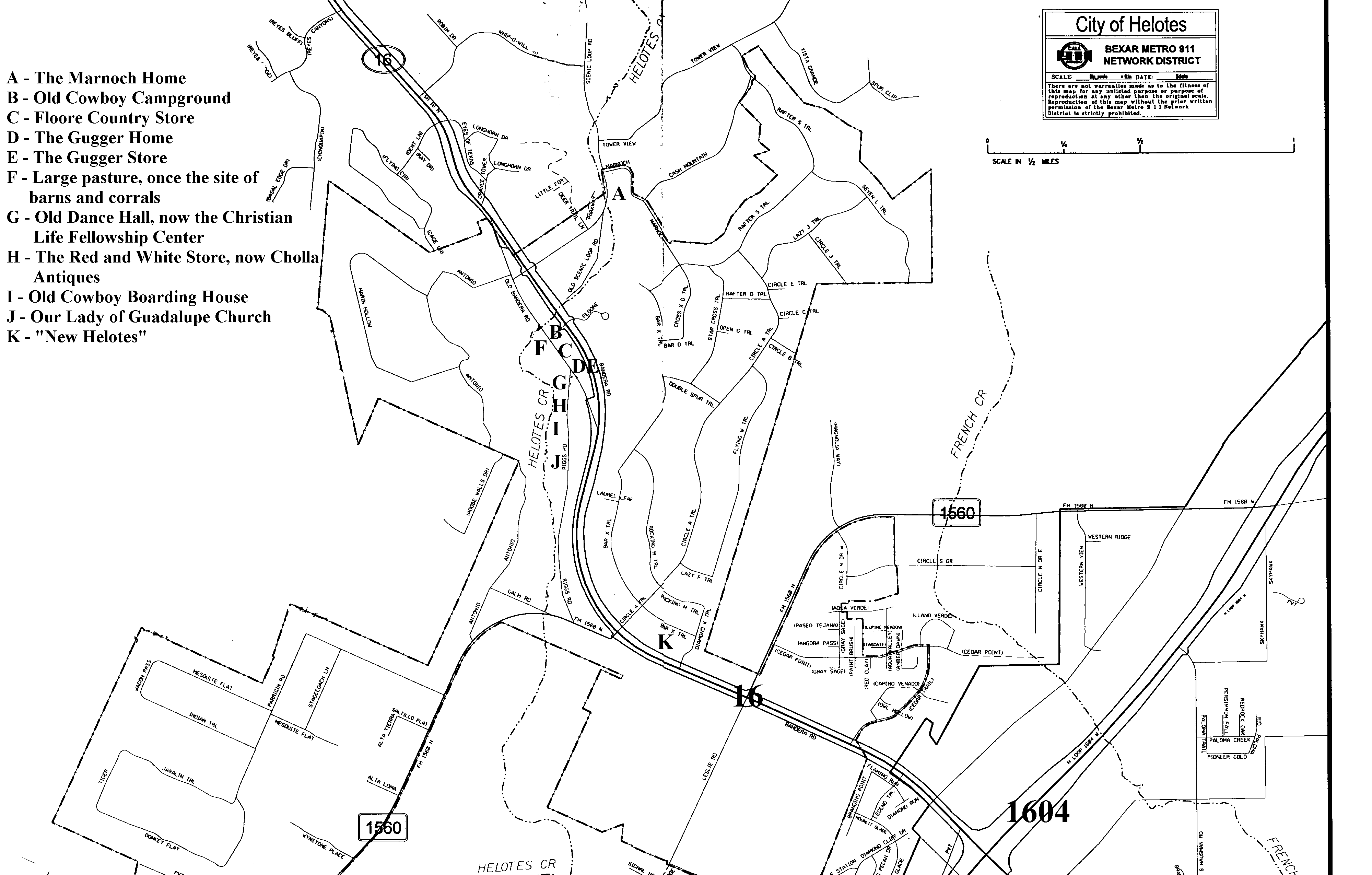
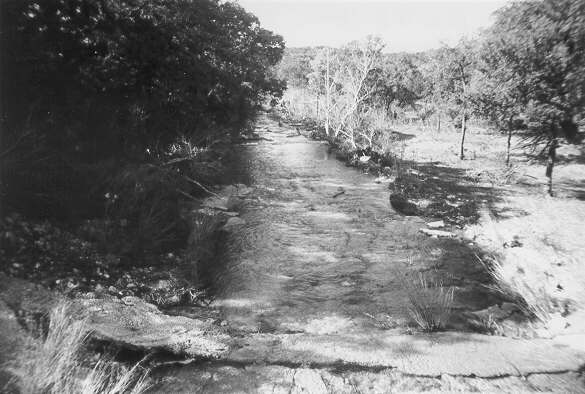 |
Helotes Creek
Photo is taken from the bridge on 'Old Helotes Highway', about 200 yards from the Gugger place. Cattle and cowboys would have over-nighted within a few yards of here. |
Historical Marker
Historical Marker placed in front of the Gugger Home, in Old Helotes. |
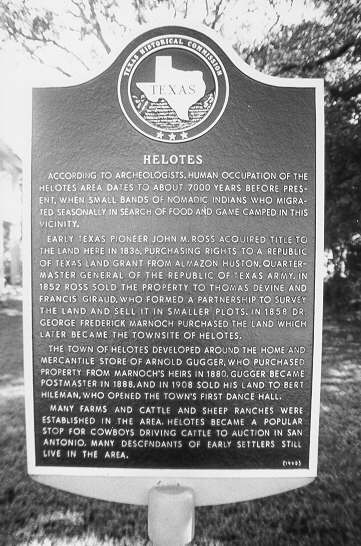 |
 |
Elizabeth Ann Menchaca, and her husband, Hawk
This picture was taken behind their residence on Menchaca Road. The house next to theirs is still in the Menchaca Family and a brick in it's wall dates the house as being built in the 1850's. Elizabeth's house is about 200 yards from a cave where the Menchacas are said to have lived. |
The Marnoch Home
The front of the Marnoch Home (now owned by Mr. Kennedy, a Grey Forest Resident). The door opens to face the west. The house seems to be a 2-story, but according to Mr. Kennedy is a 3-story. |
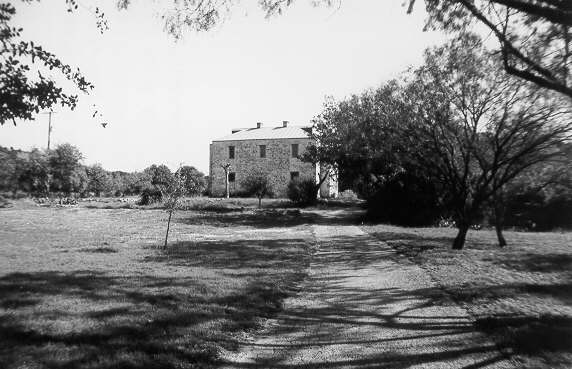 |
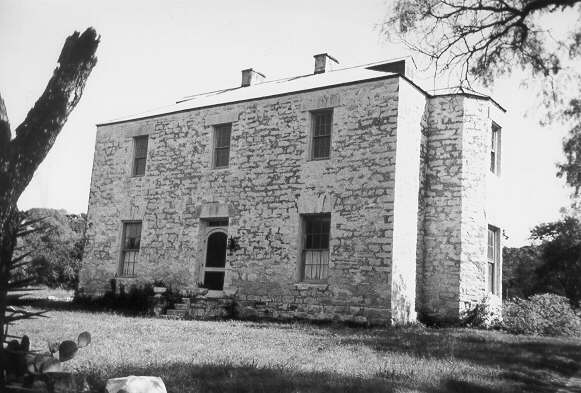 |
The Marnoch Home Front Close-up
A close-up view of front of the Marnoch Home. The stonework over the first floor windows is said to resemble architectural designs in San Antonio that are attributed to Francis Giraud.
|
The Marnoch Home Stonework
A close-up view of the stonework over one of the back (East) windows, that resembles the work of Francis Giraud. |
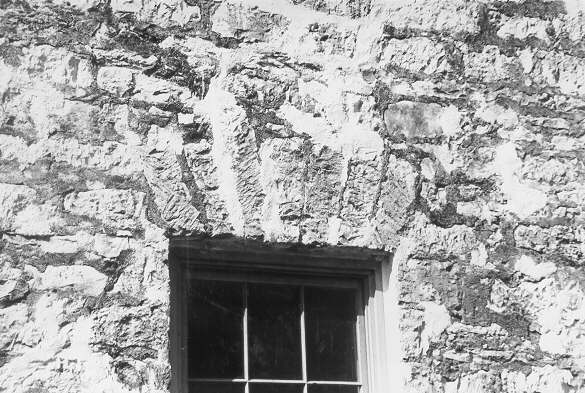 |
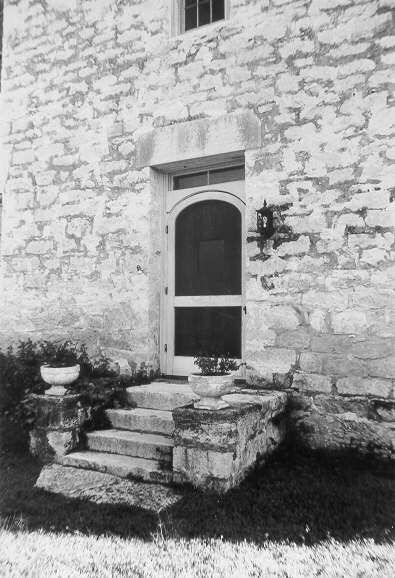 |
The Marnoch Home Front door
A close-up view of the front door and steps at the Marnoch Home. |
The Marnoch Home, back view
The southside and back view of the Marnoch Home. The back door opens to the east. |
 |
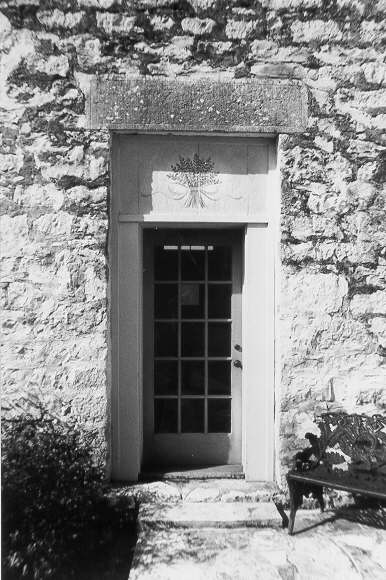 |
Back Door of the Marnoch Home
The back door of the Marnoch Home opens to the morning sun. The Marnoch Home is on Marnoch Road in Grey Forest, once a part of Helotes. |
Christian Life Fellowship
The Christian Life Fellowship occupies a building from around the turn of the 20th century. It was originally a Dance Hall. |
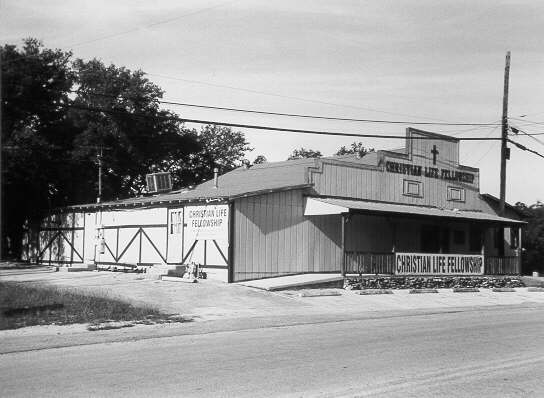 |
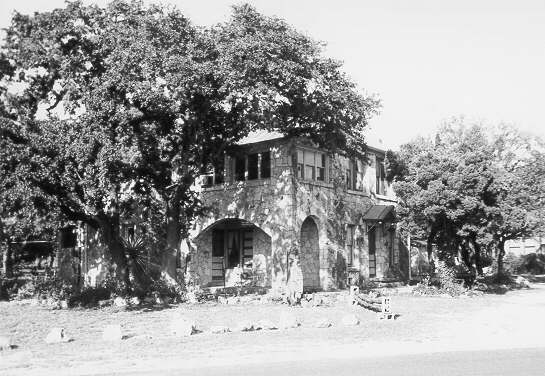 |
The Old Cowboy Boarding House
The Old Cowboy Boarding House on the east side of Riggs Road in Old Helotes was often used by cowboys going from Bandera to San Antonio. This building is wood with stone veneer. In it's original form it had a continuous porch, or at least a porch on each side. It was built on the back of it's lot and later moved to the front of the lot. |
Old Helotes
This is a picture of Old Helotes. The old Dance Hall is seen on the left (west) side of Old Bandera Road (center). The building on the right (east) side of Old Bandera Road is the Gugger Store, now the Hickory Hut BBQ. The Gugger Home is on the right beyond the store, but is not visible in this shot. The camera is pointing north. The photo was taken from the intersection of Old Bandera Road and Riggs Road. The road in this photo drops down to the bridge over Helotes Creek, about 250-300 yards from Bandera and Riggs. 100 years ago you could have stood here and seen cowboys and Indians riding horses. Now you can stand here and see cowboys and Indians riding pick-up trucks. |
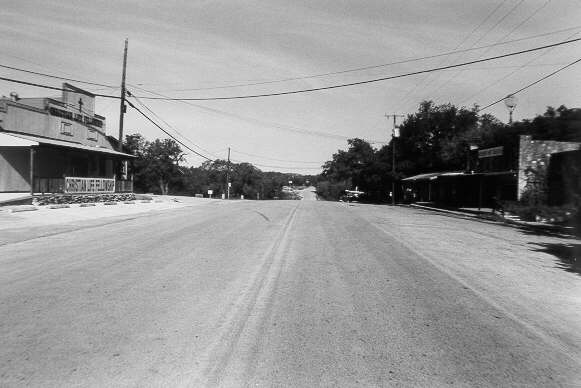 |
 |
The Gugger Home
The front view of the Gugger Home on Old Bandera Road, in Old Helotes. It is the current home of Hank and Kyle Cunningham. The lower portion of the house contains Helotes Bicycle.
The Gugger place was built in 1881, one year after the land was "conveyed" to Arnold Gugger. Local talk has it that the younger Dr. Marnoch (George) shot one of the Guggers, and the land was given as compensation. (Notice the Historical Marker to the right of the picture) |
The Gugger Home
A closer view of the Gugger Home. |
 |
 |
Formerly the Gugger Store
The Hickory Hut Bar-B-Q was formerly the Gugger Store. The Gugger Store in Old Helotes on Old Bandera Road was altered when the road was widened and paved. The original front of the building was cut off. The Gugger Home is to the left in this photo. |
Cowboy's Pasture
This pasture is on the west side of Old Bandera Road, across the street from the Gugger Place. Local talk has it that this spot once contained barns and corrals used by cowboys moving livestock from Bandera to San Antonio. The pasture is a few yards south of Helotes Creek. |
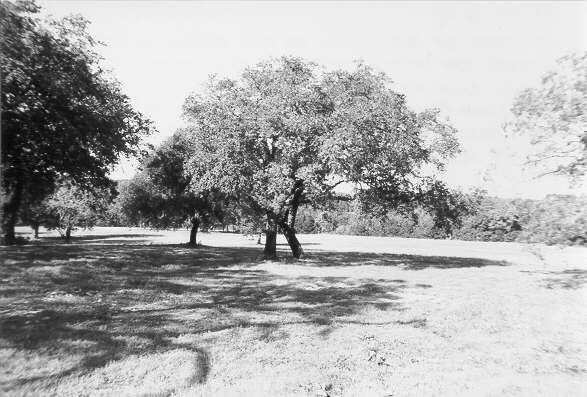 |
 |
Old Cowboy Campground
The hardware store in this photo is the suspected site of a "cowboy campground" used by cowboys moving livestock to San Antonio. The site would have had no buildings at that earlier time. The site is on the east side of Old Bandera and to the south of Helotes Creek. The bridge over Helotes Creek is seen on the left side of the photo. The suspected site of the corrals used during these "short" drives is on the left side of Old Bandera Road, pictured here. The Gugger Place is about 50 yards to the right, but is not visible in this photo. |
Cholla Antiques
Hank Cunningham mentions that this present day antique shop is located in what was called a "Red and White Store" during WWII. This building is located on the west side of Old Bandera Highway, between the old Dance Hall and the old Cowboy Boarding House. |
 |
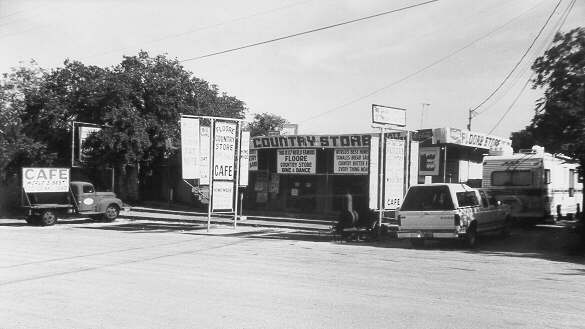 |
Floore Country Store
Floore Country Store on the east side of the Old Bandera, next to the Gugger Place, is well as one of the places where Country and Western singer Willie Nelson frequented/played early in his career. He still comes there to play from time to time. The store was built in 1942. The cluttered appearance is in keeping with the "honky-tonk" atmosphere generated during live entertainment. |
Our Lady of Guadalupe Catholic Church
The original building (foreground) of Our Lady of Guadalupe Catholic Church was built in 1957-58. The main building (background) was added later. The older building was built by parishioners, not contractors. When the church made plans to destroy the older building for expansion, Hank Cunningham and another resident served the church with a restraining order, thus preserving the original church building. |
 |
BIBLIOGRAPHY:
Cunningham, Kyle. Personal interview. 7 November, 1998.
Dallas Morning News. 1998-1999 Texas Almanac And State Industrial Guide, Dallas:
Dallas Morning News, 1998.
Freeman, Martha Doty. A History of Government Canyon State Property, Bexar County, Texas.
For Texas Parks And WildLife Department, Austin, Texas. 1994.
Gillis, Jo Ann Kesler. Helotes Happenings, Austin: Nortex, 1998.
Texas State Historical Association. The Handbook of Texas. 2 Vols. Austin: Texas State
Historical Association, 1952.
Texas State Historical Association. The Handbook Of Texas. 6 Vols. Austin: Texas State
Historical Association, 1996.
The Floore Country Store, another WWII addition to Old Helotes. It is well known to Willie Nelson fans in the area. The cluttered appearance is in keeping with the "honky-tonk" atmosphere generated during live entertainment.
WEBSITES:
Handbook of Texas Online: HELOTES, TX
Helotes Cornyval 2002
Hindu Temple of San Antonio
Return to
Small Town Research Projects Index
 The present day city of Helotes lies approximately 12 miles (direct line) Northwest of downtown San Antonio. The South-East boundary of this small, irregularly shaped municipality is now one fourth of a mile from the North-West boundary of its large, aggressive neighbor. Helotes incorporated in 1981. A 1995 almanac survey based on estimates by local officials lists the population at 1,979, and the businesses at 205.
It is currently experiencing a growth spurt accompanied by pressure from large developers to downsize the size of lots required for new homes. City Council is evenly split regarding requests to downsize lot sizes. Sandra Day O'Connor High School has been built there by the North Side Independent School District, in spite of doubts about the need for that facility.
ORIGINS:
The present day city of Helotes lies approximately 12 miles (direct line) Northwest of downtown San Antonio. The South-East boundary of this small, irregularly shaped municipality is now one fourth of a mile from the North-West boundary of its large, aggressive neighbor. Helotes incorporated in 1981. A 1995 almanac survey based on estimates by local officials lists the population at 1,979, and the businesses at 205.
It is currently experiencing a growth spurt accompanied by pressure from large developers to downsize the size of lots required for new homes. City Council is evenly split regarding requests to downsize lot sizes. Sandra Day O'Connor High School has been built there by the North Side Independent School District, in spite of doubts about the need for that facility.
ORIGINS: